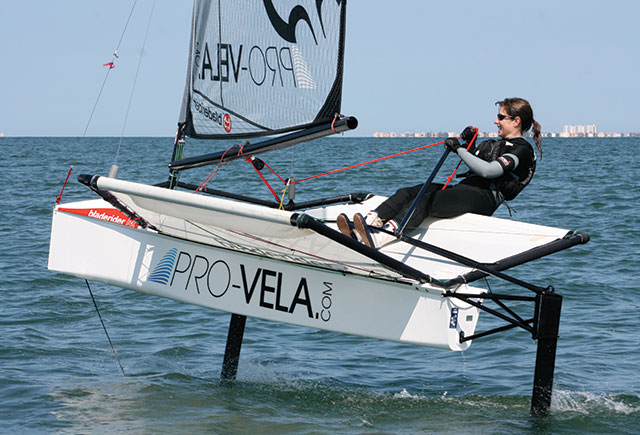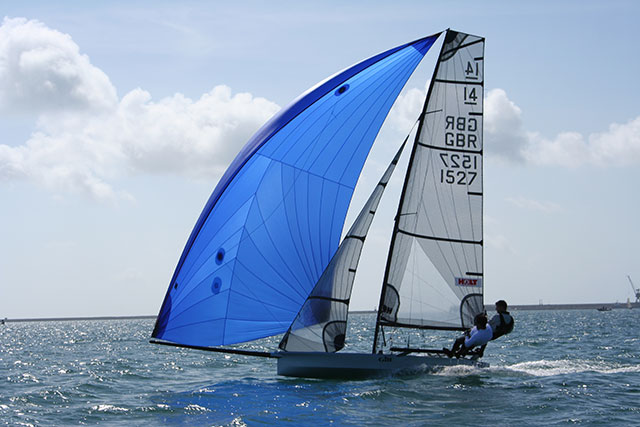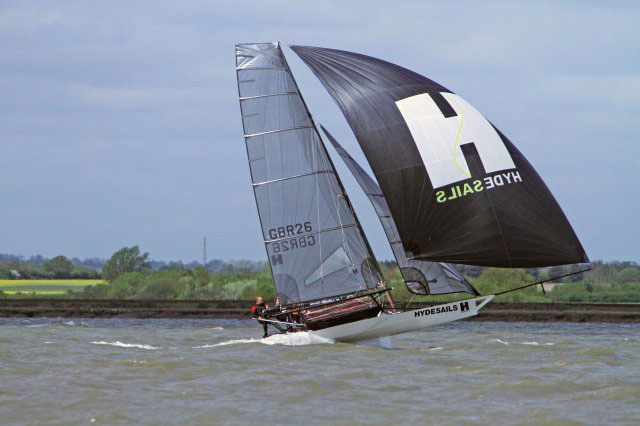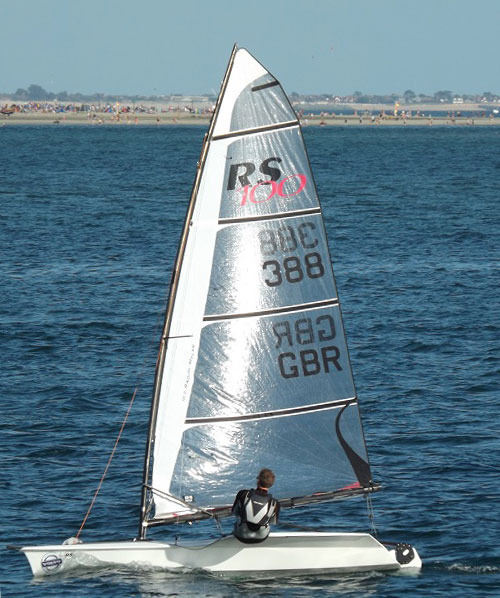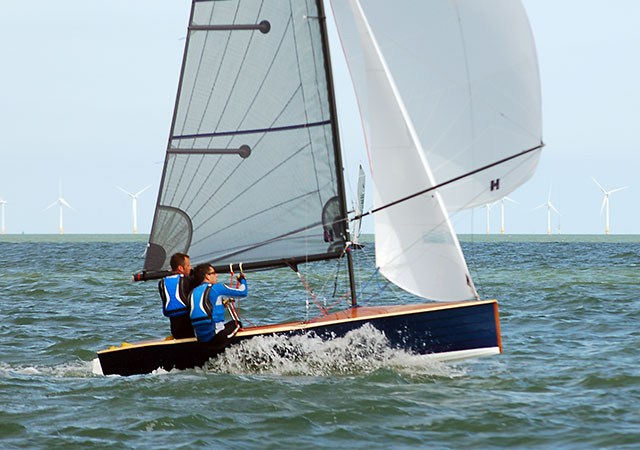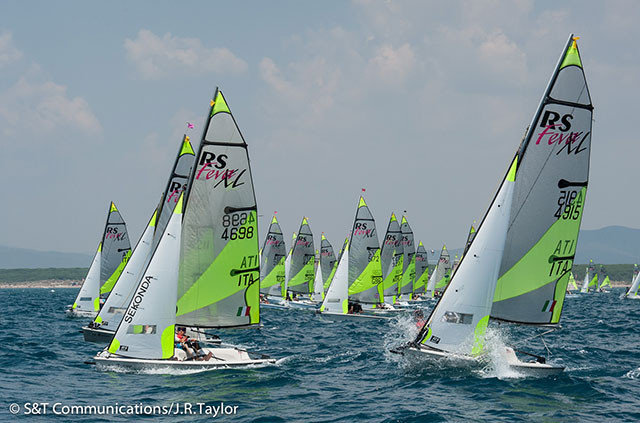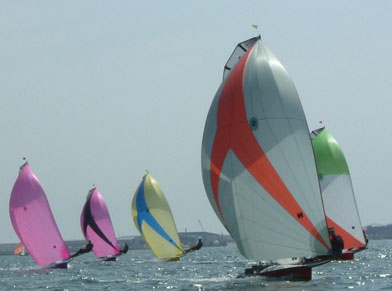Fireballs voted in top ten coolest dinghies in the world
3 October 2013
Article released on the uk.boats.com web site - written by Georgie Corlett.
What are the world's coolest dinghies? Well it's a matter of taste to some extent, but many of these amazing craft would be on anyone's list.
FOILING INTERNATIONAL MOTH - FORMULA ONE ON WATER
Skimming the surface of the water seemingly in defiance of the physics of sailing as we know it, Foiling International Moths are jaw-droppingly cool and have to feature in any list of the world's coolest dinghies. These high-tech wonders of the carbon fibre world weigh in at just 30kgs all up, and thanks to years of dedication by class devotees, airborne tacks and gybes are now feasible as standard. The exhilaration is everything you can imagine - and more. Learning to 'fly' is on the up, with the class having just held its largest ever Nationals with 69 boats. What other dinghy class can offer the lure of 'The 30 Knot Club'?! And, with the Worlds this year in Hawaii, you simply can't get any cooler.
INTERNATIONAL 14 - PERFORMANCE UNLIMITED
With an unlimited area asymmetric and 18.5m 2 of mainsail and jib area set on a carbon rig over a carbon hull, the International 14 sets the standard when it comes to uber-powerful development classes. Add a twin trapezes and a hydrofoil rudder and this boat sits off the scale. Relatively open class rules mean sailors can set the bar as high as they like and, as such, the class attracts an elite and talented crowd. It may be the oldest dinghy with 'International' status (granted by the then-IYRU in 1928), but the International 14 is a true pioneer for the future. And with a new Bieker design set to bring the price point to sub £20k, the class is working hard to open up the fleet.
18FT SKIFF - PIONEERING EXTREME SAILING WITH CRASH AND BURN ACTION
Securing a slot in the cool stakes for all perpetuity thanks to the headcams and helicopters that brought us the Awesome Aussie Skiffs videos, these three-person flying machines demonstrated the value of spectator appeal way back in the early 1990s. Ushering in a whole new era of crash and burn sailing, the 'win or swim' motto that defined the race series says it all. (Of course, there is always the alternative to get taken out by the Sydney Harbour ferry - but we wouldn't recommend that!)
RS100 - WORLD'S FASTEST SELLING PERFORMANCE SINGLEHANDER
This sexy singlehander has experienced a meteoric rise to fame since its launch in 2010, when a record number of pre-orders were taken before production had even started. Now nearly 400 boats have been sold worldwide, and at least 50 of them are expected at the class's inaugural world championship, taking place this October on the Italian icon that is Lake Como.
The RS100's sleek looks and spritely yet manageable performance under gennaker have not only secured its popularity amongst the masses, but also won it numerous accolades, with a recently-granted ISAF 'international class' status to top it off.
MERLIN ROCKET - THE ULTIMATE DEVELOPMENT CLASS
Like a fine wine, the Merlin has matured to perfection. The class's trademark saucer-like clinker hull has morphed and broadened over time to ensure the hull gives sufficient righting moment to cope with the powerful high-aspect rig - without needing a trapeze. Pop the updated 10m 2 symmetric spinnaker and these boats simply fly off-wind, even on a close reach; upwind, the sophisticated rig makes planning a perfect probability in the breeze. A breeding ground for famous dinghy sailors - from its designer Jack Holt through to 2012 Olympic medalists Luke Patience and Stuart Bithell - this thriving development class is justifiably known for its friendly yet tough competition.
49ER FX - GIRL POWER GOES OLYMPIC
This twin trapeze speedster has evolved from the 49er - the ultimate Olympic performance boat that made its debut at the 2000 Olympics. Now, sporting a shorter, lower aspect ratio sailplan from Mackay Boats, the 49er FX is getting ready to take centre stage as the new women's Olympic class in Rio in three years time. Since its selection, women around the world have been making the switch and learning to handle the highly efficient sail, which allows lightweight (120kg) crews to compete on a par with the 49er downwind; less likely to nose dive and easier to handle - albeit with a 25sq m gennaker - the 49er FX delivers 110 per cent of pure girl power.
RS FEVA - FOR TEENAGE KICKS
Undeniably, for any under-16 sailor seeking instant boat park cred, this is the class to be in. Whether you are new to sailing and still finding your feet with the small sails, or have mastered the XL Mylar rig and are competing on the huge national and international circuit, this dinky double-hander is the way to go. Lightweight, robust and simple to rig, it's a no-brainer investment for parents and schools; whilst it's funky modern branding and all the skills and speed that its asymmetric kite involve make it irresistibly cool for kids.
FOXER - KEEPING THINGS SIMPLE
Some 20 years ago, the Hamble Foxer popped onto the scene, winning instant approval from many of the UK's finest sailors. The brainchild of Hedley Bewes and designer David Thomas, this one-design 11-footer with single sail rig is the epitome of simplicity - precisely what makes it so appealing! Its responsive handling make it perfect for darting in and out of the moored yachts on the Hamble, and with a year-round race programme for the 50-strong fleet, this is the go-to class for an impressive roll-call of national and international yachting champions seeking the purist side of dinghy racing.
FIREBALL - RETRO CHIC SPEEDSTER
Its 1960's scow-shaped hull may raise eyebrows, but this 16-foot single-trapeze asymmetric is undoubtedly fast - regardless of direction or crew weight. Class rules define it as a one-design yet give plenty of flexibility to accommodate a range of helm-crew combos. With a reputation for speed over both flat water and waves, the Fireball certainly has mass appeal - proof of which comes in its large UK fleets and equally strong international following; whether that's from its ability to plane almost on demand, the powerful symmetrical spinnaker, or the ultra-adjustable rig which ensures you can tame its power to suit, the Fireball delivers a perfect package.
ASYMMETRIC CANOE - QUIRKILY COOL AND UTTERLY UNIQUE
With a family tree that stretches way back to the paddle canoes of the mid-1800s, this most progressive branch of the 'Canoe' development class is distinguished by a mammoth masthead asymmetric. The combined challenge of mastering the unique sliding seat - projecting the helm more than two metres out from the centerline - whilst handling the 23sq m kite class continues to attract new sailors. ACs, as they are known, can often be found racing on the same track as the equally eccentric International Canoe, which also sports a sliding seat and conforms to similar dimensions but with its own class-specific nuances and, notably, without kite.
